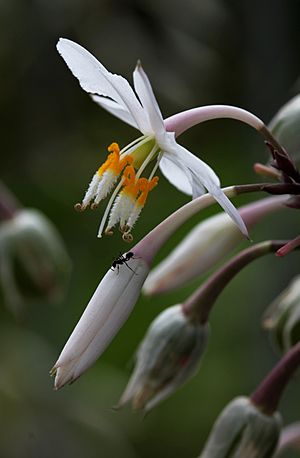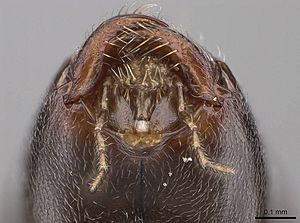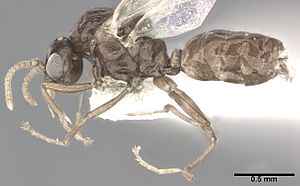Ochetellus glaber facts for kids
Quick facts for kids Ochetellus glaber |
|
|---|---|
 |
|
| Ochetellus glaber worker | |
| Scientific classification | |
| Kingdom: | |
| Phylum: | |
| Class: | |
| Order: | |
| Family: | |
| Subfamily: |
Dolichoderinae
|
| Genus: | |
| Species: |
O. glaber
|
| Binomial name | |
| Ochetellus glaber (Mayr, 1862)
|
|
| Subspecies | |
|
|
| Synonyms | |
|
|
The Ochetellus glaber ant, also known as the black household ant, is a small ant that comes from Australia. It belongs to a group of ants called Ochetellus. An Austrian scientist named Gustav Mayr first described this ant in 1862.
Besides Australia, O. glaber has traveled to many other countries. You can find it in places like China, India, Japan, New Zealand, the Philippines, and parts of the United States, such as Hawaii and Florida. It also lives on islands like Lord Howe Island, New Caledonia, and the Solomon Islands. These ants are quite small. Worker ants are about 2 to 3 millimeters long. Male ants are even smaller, around 1.6 millimeters. Queen ants are the largest, measuring about 5.2 to 5.5 millimeters. Their color can be brown or black.
O. glaber ants often build their nests in trees or under rocks and logs. They are active both day and night, looking for food like sweet honeydew and insects. They can sometimes become a pest when they enter human homes to find food.
Contents
Ant Classification: The Ochetellus glaber Story
The Ochetellus glaber ant was first named Hypoclinea glabra by Gustav Mayr in 1862. He found these ants in Sydney, Australia. Later, in 1865, Mayr moved the ant to a different group called Iridomyrmex.
For over 100 years, it stayed in the Iridomyrmex group. But in 1992, a scientist named Steve Shattuck created a new group, Ochetellus, and moved the ant there. He also made O. glaber the main example for this new group. Scientists now think that O. glaber might actually be a group of very similar ants, not just one single species.
This ant has two older names that are no longer used: Iridomyrmex itoi and Iridomyrmex itoi abbotti. These names were later found to be the same ant as O. glaber. People sometimes call this ant the black house ant or the tramp ant.
What Ochetellus glaber Looks Like
O. glaber ants are small. Worker ants are usually 2 to 3 millimeters long. They have 12 segments on their antennae, which are about half the length of their head. Their eyes can be medium or large, with many small lenses. The top part of their body (mesosoma) has clear grooves and no standing hairs. The last part of their thorax (propodeum) has a distinct bump.
These ants have only one segment in their waist. The narrow waist part (petiole) stands upright. Their body color can be brown or black.
Male ants are smaller than workers, about 1.6 millimeters long. Their bodies are brown, but the back part is brownish-black. Their mouthparts, legs, and antennae are yellow. Their head and chest often look wrinkled.
Queen ants are the biggest, measuring 5.2 to 5.5 millimeters.
Young ant larvae (baby ants) are about 1.4 millimeters long. They are thicker and straighter than older larvae. They have tiny spines, especially at their back end. Their body hairs are very short.
Older larvae are larger, about 3.9 millimeters long. Their bodies are short and thick. Their outer skin has small spines, especially on the underside and back. They have some body hair, but not much on their head. Their mouthparts have a large tooth. Unlike other ants in their group, these larvae are yellow, not white.
Scientists have also studied the chromosomes of O. glaber. They found that it has 14 chromosomes.
Types of O. glaber Ants
There are three recognized types (subspecies) of O. glaber:
- O. glaber clarithorax
- O. glaber consimilis
- O. glaber sommeri
Where Ochetellus glaber Lives and Nests

O. glaber ants live in many places across Oceania. In Australia, they are found along the coasts of Queensland and New South Wales, and in south-west Western Australia.
These ants were brought to New Zealand around 1927 and became common by the 1940s. While they mostly stay in Auckland and its suburbs, they could spread to other cities. They are seen as a possible pest, but not a major one in homes. They have also been found on Lord Howe Island, New Caledonia, Norfolk Island, and the Solomon Islands.
Other countries where O. glaber has been found include Réunion, India, and the Philippines. In India, they have been collected in several states. They are also in China, Macau, Japan, and Sri Lanka. In the United States, they were first seen in Hawaii in 1977, coming from Australia and Japan. Now, they are on several Hawaiian islands. They were also found in Florida, living in dead wood or marsh grasses.
O. glaber ants often build their nests in trees. They live in open areas or savannah woodlands. Their nests can be under stones, in old dry logs, inside hollow trees, plant stems, or rotten wood. You can also find them in gardens. They live at different heights, from 5 to 1585 meters above sea level.
In buildings, O. glaber ants make nests in cracks and holes. This includes places like rockeries, paving, brickwork, ceilings, walls, and under floors.
Ochetellus glaber Behavior and Life Cycle

O. glaber ants eat many different things. They form long lines on tree trunks to find sweet substances like honeydew and to hunt insects. They are active both during the day and at night. Their activity increases at night or on cloudy days, especially in the early mornings and late evenings.
These ants eat dead birds, sea turtles, fish, and insect larvae. They also like fat, grease, plants, and seeds. They sometimes invade the nests of termites, but they are not as dangerous to termites as some other ant species.
O. glaber ants interact with many other living things. Worker ants often visit flowers to drink nectar, especially from Pisonia plants. They also visit flowers like Canavalia and Ipomoea. These ants also work with insects like pineapple mealybugs and aphids. They will even bring these bugs to house plants and take care of them.
During their mating flight, a queen ant might mate with several male ants. However, each male ant only mates with one queen. Sometimes, a part of an ant colony, including queens, workers, and young ants (eggs, larvae, and pupae), will leave the main nest to start a new one. This is called "budding."
Ochetellus glaber and Humans
O. glaber ants are often seen as a pest. They don't sting, but they can bite. When you crush them, they give off a strong smell. They often come into human homes to find food, walking across ceilings and beams. They can drop ant bits onto surfaces below. These ants can spread quickly because they reproduce a lot and can move to new places easily.
In some places, O. glaber can be more of a problem. For example, the United States, especially California, tries to stop these ants from entering. This is because they could harm the local environment. Their relationship with honeydew-producing insects and their eating of other helpful insects could upset the natural balance that controls pests. This might cause long-term damage to the environment, reducing the variety of living things or changing how ecosystems work.
Because of this, the California Department of Food and Agriculture has stopped these ants from entering with plants from Hawaii. California is especially at risk because its weather is similar to places where these ants already live. However, O. glaber is not likely to cause big problems for crops or farming costs in California.
In New Zealand, these ants are mostly found in city gardens and some homes.
See also
 In Spanish: Ochetellus glaber para niños
In Spanish: Ochetellus glaber para niños





